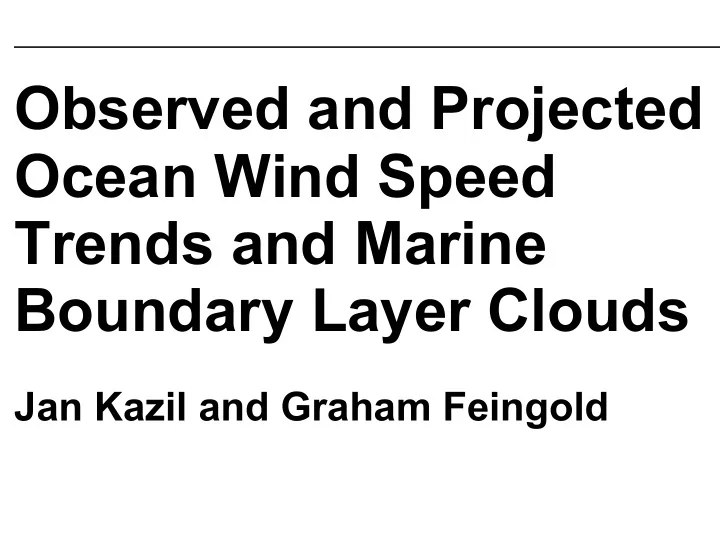

Observed and Projected Ocean Wind Speed Trends and Marine Boundary Layer Clouds Jan Kazil and Graham Feingold
Annual mean 10 m wind speed trend 1991 - 2008 +1.5 % +1.0 % +0.5 % 0 % -0.5 % -1.0 % -1.5 % Young et al. (Nature, 2011) Satellite radar altimeter Wave height 10 m wind speed
JJA 10 m wind speed in 2081–2100 relative to 1981–2000 -10% -5% 0% 5% 10% McInnes et al. (Atm. Sci. Lett., 2011) WCRP CMIP3 model mean 19 coupled climate models A1B emission scenario
Wind speed Drives Increases Moistens the Warms the non-thermal CCN number boundary boundary turbulence, layer layer shear Horizontal Latent heat Sensible heat Sea spray momentum
Simulations – WRF North-east Pacific DYCOMS II RF02 Different domain sizes and resolutions South-east Pacific VOCALS RF14 Different domain sizes and resolutions Geostrophic wind speed: Fast (average + 25 %) All else equal Average (observations) Slow (average – 25 %)
Cloud field VOCALS (after 12 h) DYCOMS II (after 6 h) +18 % Response? -18 %
Net down-welling radiation DYCOMS II RF02 VOCALS RF14 +6.3 W m -2 Faster wind +4.83 W m -2 -0.99 W m -2 Slower wind -5.83 W m -2
Decoupling due to wind shear? More entrainment Shear Water vapor gradient Less latent heat u resolved (m s -1 ) Cloud water (g kg -1 ) Water vapor (g kg -1 ) Θ l (K)
Two different decoupling mechanisms at play? DYCOMS II RF02 VOCALS RF14
Wind speed effects on non-precipitating Sc Faster wind speed → higher radiative forcing Slower wind speed → reduced radiative forcing Different decoupling mechanisms depending on boundary layer depth? ● Faster wind speed → Stronger wind shear at inversion → more entrainment → decoupling ● Faster wind speed → Stronger latent heat flux → stronger drizzle → humidification of sub- cloud layer → decoupling
Path forward ● Simulations with higher resolution ● Isolate effect of different mechanisms ● Analyze observations for wind speed effects: MAGIC!
Response to wind speed (VOCALS RF14)
Response to wind speed (DYCOMS II RF02)
Asymmetric response due to solar heating Faster wind speed → more decoupling Slower wind speed → less decoupling Solar heating adds to decoupling in both cases
Recommend
More recommend